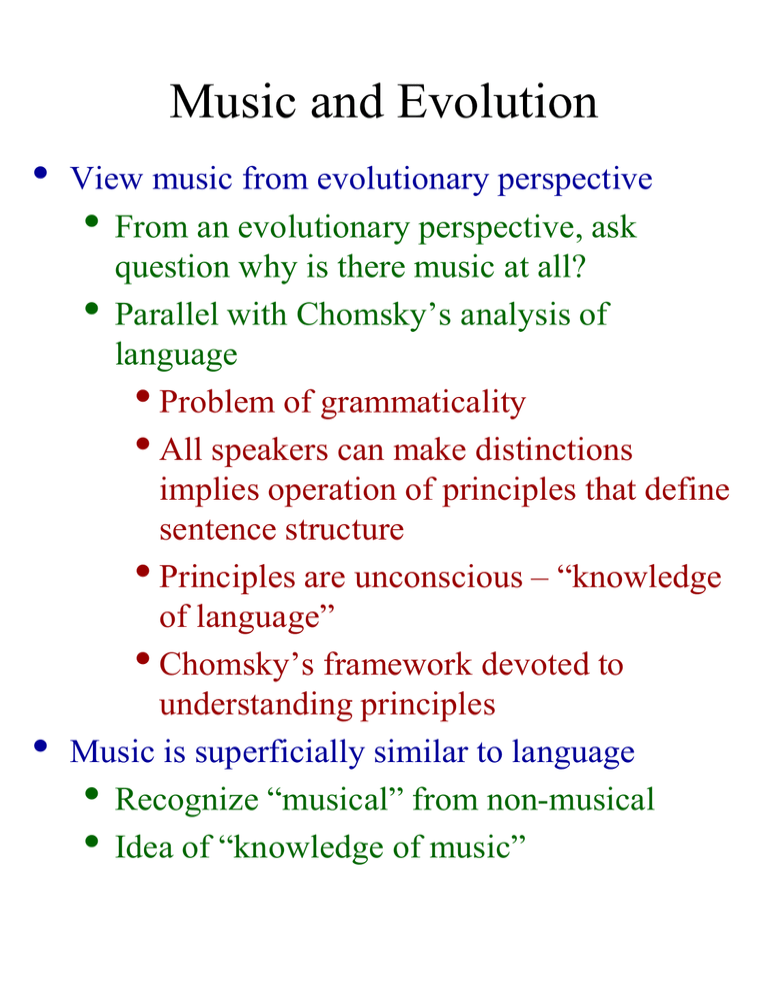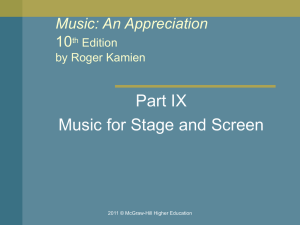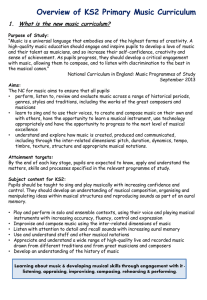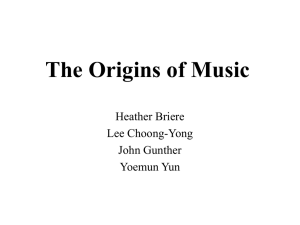Music and Evolution - University of Toronto Scarborough
advertisement

Music and Evolution • • View music from evolutionary perspective • From an evolutionary perspective, ask question why is there music at all? • Parallel with Chomsky’s analysis of language • Problem of grammaticality • All speakers can make distinctions implies operation of principles that define sentence structure • Principles are unconscious – “knowledge of language” • Chomsky’s framework devoted to understanding principles Music is superficially similar to language • Recognize “musical” from non-musical • Idea of “knowledge of music” Three main questions about music and evolution • • • What is the initial, innate state of knowledge about music prior to experience? • Idea of universal constraints • Ex, Idea of scale structure How is this initial state of knowledge transformed by relevant experience into the mature state of knowledge? • Is there a critical period for acquisition of musical knowledge? • Is there a “poverty of the stimulus” problem? • Problem of grammaticality What is the evolutionary history of the initial state and the acquisition processes that guide the development of musical knowledge? • Question of music as an adaptation The evolution of music • Is music an “adaptation”? • Adaptation – a feature that becomes important for the survival and reproduction of the organism • In what way is music adaptive The evolution of music • Steven Pinker’s, How the mind works (1997) • The arts have two functions – instruction and entertainment • Instruction may have adaptive value • Music is primarily entertainment • The arts respond to “a biologically pointless • • challenge: figuring out how to get at the pleasure circuits of the brain and deliver little jolts of enjoyment without the inconvenience of wringing bona fide fitness increments from the harsh world” (p. 524) “music is auditory cheesecake, an exquisite confection crafted to tickle the sensitive spots of at least six of our mental faculties” (p. 534) “Compared with language, vision, social reasoning, and physical know-how, music could vanish from our species and the rest of our lifestyle would be virtually unchanged. Music appears to be a pure pleasure technology, a cocktail of recreational drugs that we ingest through the ear to stimulate a mass of pleasure circuits at once" (p. 528). The adaptive functions of music • • • Music promotes group cohesion • Music developed from mother-infant bonding • Strengthens emotional bonds • Music transmits emotional information to a group of people simultaneously Music is a product of group selection • Individual interests often served by cooperating rather than competition with other individuals of species • Thus, likelihood of individual surviving and procreating depends on “cultural fitness”, how they behave in relation to others in social group Music promotes sexual selection • musical behaviors indicate sexual fitness on variety of levels (Miller, 2000a, 2000b) Evidence for innate mechanisms in music • Developmental evidence • Difficulties with interpreting developmental evidence • Issues with idea of lack of exposure • Issues with methodology • Developmental evidence of innate sensitivity to musical structure • Sensitivity to basic musical parameters – pitch, intervals, contour, rhythm • Issue of rapid learning and experience in utero Evidence for innate mechanisms in music • Cross-cultural evidence • Two lines of investigation • Search for cross-cultural universals • Music in ancient cultures • Cross-cultural universals? • Aspects of pitch: • The distinction between relative and absolute pitch • Melody recognition • Scale structure • Musical intervals • Lullabies Evidence for innate mechanisms in music • Comparative evidence • Why study animals? • See if trait is unique to humans • Homology vs. Homoplasy • Homology: A trait that’s inherited from a • common ancestor • Homoplasy: A trait with distinct lineages, lacking a common ancestor Powerful tool for evolutionary arguments • Can control exposure • Animals do not naturally produce music, thus any perceptual effects cannot be part of adaptation for music • Nature of the evidence? • Production of musical passages by animals • Birds, gibbons and whale songs • Perception of musical structure in animals • Pitch perception, consonance and dissonance, musical styles • Concerns with overstating evidence Evidence for innate mechanisms in music • Neural evidence • Neuropsychology and imagining techniques • Evidence for distinct neural structures related to • musical processing – distinct mechanisms for music? Are these brain structures innate, or do they come about through experience? Conclusions • • Suggestive evidence that structure of music constrained by innate features of brain • Work on pitch Question of whether music is an adaptation or byproduct of auditory process still remains • Octaves vs. musical intervals











